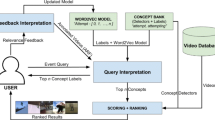Abstract
There is an increasing emphasis on including semantic concept detection as part of video retrieval. This represents a modality for retrieval quite different from metadata-based and keyframe similarity-based approaches. One of the premises on which the success of this is based, is that good quality detection is available in order to guarantee retrieval quality. But how good does the feature detection actually need to be? Is it possible to achieve good retrieval quality, even with poor quality concept detection and if so then what is the “tipping point” below which detection accuracy proves not to be beneficial? In this paper we explore this question using a collection of rushes video where we artificially vary the quality of detection of semantic features and we study the impact on the resulting retrieval. Our results show that the impact of improving or degrading performance of concept detectors is not directly reflected as retrieval performance and this raises interesting questions about how accurate concept detection really needs to be.
Preview
Unable to display preview. Download preview PDF.
Similar content being viewed by others
References
Smeaton, A.F., Over, P., Kraaij, W.: High-Level Feature Detection from Video in TRECVid: a 5-Year Retrospective of Achievements. In: Divakaran, A. (ed.) Multimedia Content Analysis, Theory and Applic., pp. 151–174. Springer, Berlin (2009)
Hauptmann, A.G., Yan, R., Lin, W.H., Christel, M.G., Wactlar, H.D.: Can high-level concepts fill the semantic gap in video retrieval? a case study with broadcast news. IEEE Transactions on Multimedia 9(5), 958–966 (2007)
Christel, M.G., Hauptmann, A.G.: The use and utility of high-level semantic features in video retrieval. In: Leow, W.-K., Lew, M., Chua, T.-S., Ma, W.-Y., Chaisorn, L., Bakker, E.M. (eds.) CIVR 2005. LNCS, vol. 3568, pp. 134–144. Springer, Heidelberg (2005)
Wei, X.Y., Ngo, C.W.: Fusing semantics, observability, reliability and diversity of concept detectors for video search. In: Proc. MM 2008, pp. 81–90. ACM, New York (2008)
Snoek, C.G.M., Worring, M.: Are concept detector lexicons effective for video search? In: ICME, pp. 1966–1969. IEEE, Los Alamitos (2007)
Wang, M., Hua, X.S.: Study on the combination of video concept detectors. In: Proc. MM 2008, pp. 647–650. ACM, New York (2008)
Smeaton, A.F., Over, P., Kraaij, W.: Evaluation campaigns and trecvid. In: Proc. MIR 2006, pp. 321–330. ACM Press, New York (2006)
Naphade, M.R., Kennedy, L., Kender, J.R., Chang, S.F., Smith, J.R., Over, P., Hauptmann, A.: A light scale concept ontology for multimedia understanding for TRECVID 2005. Tech. Rep. RC23612, IBM T.J. Watson Research Center (2005)
Toharia, P., Robles, O.D., Pastor, L., Rodríguez, A.: Combining activity and temporal coherence with low-level information for summarization of video rushes. In: Proc. TVS 2008, pp. 70–74. ACM, New York (2008)
O’Connor, N., Cooke, E., le Borgne, H., Blighe, M., Adamek, T.: The acetoolbox: Low-level audiovisual feature extraction for retrieval and classification. In: Proc. EWIMT 2005 (2005)
Author information
Authors and Affiliations
Editor information
Editors and Affiliations
Rights and permissions
Copyright information
© 2009 Springer-Verlag Berlin Heidelberg
About this paper
Cite this paper
Toharia, P., Robles, O.D., Smeaton, A.F., Rodríguez, Á. (2009). Measuring the Influence of Concept Detection on Video Retrieval. In: Jiang, X., Petkov, N. (eds) Computer Analysis of Images and Patterns. CAIP 2009. Lecture Notes in Computer Science, vol 5702. Springer, Berlin, Heidelberg. https://doi.org/10.1007/978-3-642-03767-2_71
Download citation
DOI: https://doi.org/10.1007/978-3-642-03767-2_71
Publisher Name: Springer, Berlin, Heidelberg
Print ISBN: 978-3-642-03766-5
Online ISBN: 978-3-642-03767-2
eBook Packages: Computer ScienceComputer Science (R0)




